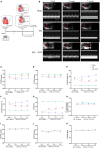A Modified Surgical Ventricular Reconstruction in Post-infarction Mice Persistently Alleviates Heart Failure and Improves Cardiac Regeneration
- PMID: 35004900
- PMCID: PMC8740235
- DOI: 10.3389/fcvm.2021.789493
A Modified Surgical Ventricular Reconstruction in Post-infarction Mice Persistently Alleviates Heart Failure and Improves Cardiac Regeneration
Abstract
Objectives: Large ventricular aneurysm secondary to myocardial infarction (MI) results in severe heart failure (HF) and limits the effectiveness of regeneration therapy, which can be improved by surgical ventricular reconstruction (SVR). However, the conventional SVR procedures do not yield optimal long-term outcome in post-MI rodents. We hypothesized that a modified SVR procedure without aggressive purse string suture would persistently alleviate HF and improve cardiac regeneration in post-MI mice. Methods: Adult male C57 mice were subjected to MI or sham surgery. Four weeks later, mice with MI underwent SVR or 2nd open-chest operation alone. SVR was performed by plicating the aneurysm with a single diagonal linear suture from the upper left ventricle (LV) to the right side of the apex. Cardiac remodeling, heart function and myocardial regeneration were evaluated. Results: Three weeks after SVR, the scar area, LV volume, and heart weight/body weight ratio were significantly smaller, while LV ejection fraction, the maximum rising and descending rates of LV pressure, LV contractility and global myocardial strain were significantly higher in SVR group than in SVR-control group. The inhibitory effects of SVR on LV remodeling and HF persisted for at least eight-week. SVR group exhibited improved cardiac regeneration, as reflected by more Ki67-, Aurora B- and PH3-positive cardiomyocytes and a higher vessel density around the plication area of the infarcted LV. Conclusions: SVR with a single linear suture results in a significant and sustained reduction in LV volume and improvement in both LV systolic and diastolic function as well as cardiac regeneration.
Keywords: heart failure; myocardial infarction; myocardial regeneration; surgical ventricular reconstruction; ventricular aneurysm.
Copyright © 2021 Ma, Yan, Yang, Liao, Bin, Lin and Liao.
Conflict of interest statement
The authors declare that the research was conducted in the absence of any commercial or financial relationships that could be construed as a potential conflict of interest.
Figures







Similar articles
-
CircMap4k2 reactivated by aneurysm plication alleviates residual cardiac remodeling after SVR by enhancing cardiomyocyte proliferation in post-MI mice.J Adv Res. 2024 Nov;65:227-238. doi: 10.1016/j.jare.2023.11.034. Epub 2023 Dec 2. J Adv Res. 2024. PMID: 38043608 Free PMC article.
-
Dapagliflozin attenuates residual cardiac remodeling after surgical ventricular reconstruction in mice with an enlarged heart after myocardial infarction.Biomed Pharmacother. 2022 Dec;156:113765. doi: 10.1016/j.biopha.2022.113765. Epub 2022 Oct 10. Biomed Pharmacother. 2022. PMID: 36228368
-
Clinical aspects of left ventricular diastolic function assessed by Doppler echocardiography following acute myocardial infarction.Dan Med Bull. 2001 Nov;48(4):199-210. Dan Med Bull. 2001. PMID: 11767125 Review.
-
Characterization of dysfunctional remote myocardium in left ventricular anterior aneurysms and improvements following surgical ventricular restoration using cardiac magnetic resonance imaging: preliminary results.Interact Cardiovasc Thorac Surg. 2014 Sep;19(3):368-74. doi: 10.1093/icvts/ivu162. Epub 2014 Jun 6. Interact Cardiovasc Thorac Surg. 2014. PMID: 24907238
-
Hybrid transcatheter left ventricular reconstruction for the treatment of ischemic cardiomyopathy.Cardiovasc Diagn Ther. 2021 Feb;11(1):183-192. doi: 10.21037/cdt-20-265. Cardiovasc Diagn Ther. 2021. PMID: 33708491 Free PMC article. Review.
Cited by
-
Bioinformatics exploration of potential common therapeutic targets for systemic and pulmonary arterial hypertension-induced myocardial hypertrophy.Acta Biochim Biophys Sin (Shanghai). 2023 May 25;55(5):831-841. doi: 10.3724/abbs.2023071. Acta Biochim Biophys Sin (Shanghai). 2023. PMID: 37232575 Free PMC article.
-
Revascularization of chronic total occlusion coronary artery and cardiac regeneration.Front Cardiovasc Med. 2022 Aug 25;9:940808. doi: 10.3389/fcvm.2022.940808. eCollection 2022. Front Cardiovasc Med. 2022. PMID: 36093131 Free PMC article. Review.
-
CircMap4k2 reactivated by aneurysm plication alleviates residual cardiac remodeling after SVR by enhancing cardiomyocyte proliferation in post-MI mice.J Adv Res. 2024 Nov;65:227-238. doi: 10.1016/j.jare.2023.11.034. Epub 2023 Dec 2. J Adv Res. 2024. PMID: 38043608 Free PMC article.
References
-
- Bolognese L, Neskovic AN, Parodi G, Cerisano G, Buonamici P, Santoro GM, et al. . Left ventricular remodeling after primary coronary angioplasty: patterns of left ventricular dilation and long-term prognostic implications. Circulation. (2002) 106:2351–7. 10.1161/01.CIR.0000036014.90197.FA - DOI - PubMed
LinkOut - more resources
Full Text Sources
Research Materials
Miscellaneous

